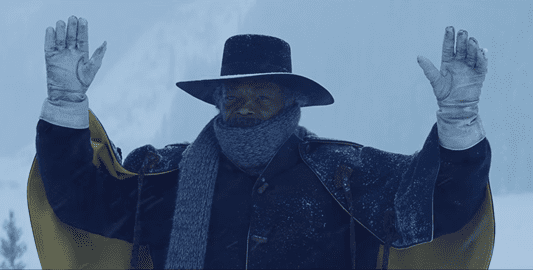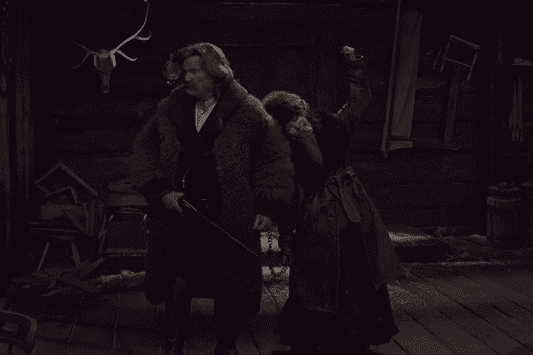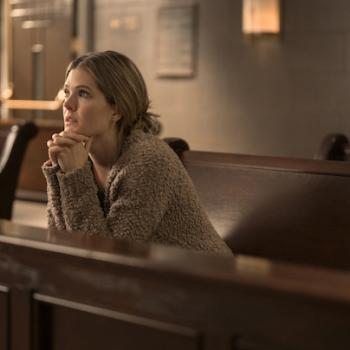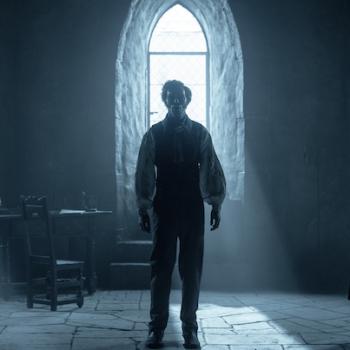
Quentin Tarantino frustrates the snot out of me. He is, unquestionably, a master craftsman. He has an eye for breathtaking visuals, an ear for mesmerizing, often gorgeous dialogue. But he has a taste for blood, too—so much so that his movies require a separate budget for it. And it often spoils his movies.
I know, I know. The blood is all for show, I’m told. It’s meant to look fake and stylized and, in some strange way, pull us out of the story. To remind us that we’re just watching a movie. If someone got a paper cut in a Tarantino movie, that someone would most likely use a half a pint of “Tarantino Red” before tracking down a Band-Aid.
But for me, Tarantino’s reliance on blood and gore is both disgusting and distracting—the director’s 14-year-old id coming out to spoil the lavish story that the adult Tarantino wanted to tell. The Hateful Eight is a particularly infuriating movie to watch: I loved how Dana Stevens of Slate put it: “The Hateful Eight is bold, gorgeous, verbally clever, morally repellent, and, in some way I am still struggling to put my finger on, possibly somehow evil.”
Tarantino clearly loves his blood. But why? Is there something deeper going on here than just the deep red that spatters the screen? As much as I tire of Tarantino’s obsession with spatter, I think there’s also something interesting at work here. Caution: Spoilers ahead.

Tarantino’s Altar
Blood is a big deal. We need it to live. Without it, we’re dead. Vampires—those undead creatures of the night—drink it by the pint for a reason.
Naturally, blood has always been a critical component in religion. Almost every faith tradition has featured blood sacrifices as an important part of its past—often to appease a bloodthirsty deity of some sort. If blood is life, the taking and/or giving of that blood is a powerful act—not just temporally, but spiritually, as well.
No surprise, then, that blood’s a huge deal within Old Testament Judaism and Christianity. Jews painted it on their doors so the angel of death would pass over their homes. They would sprinkle or splash it on their altars. Blood was the most valuable thing that someone could possess or give, and so naturally it was a powerful symbol of sacrifice. And most importantly, it was the only thing that could wash away someone’s sins. “For the life of the flesh is in the blood, and I have given it for you on the altar to make atonement for your souls,” God says in Leviticus 17:11 (ESV), “for it is the blood that makes atonement by the life.”
That’s one of the reasons why, in Christianity, Jesus’ death on the cross is so significant: The blood He spilled was enough (we Christians believe) to scrub clean all our sins. His sacrifice eliminated our need for all those bloody sacrifices.
We see Jesus in The Hateful Eight. Indeed, He’s the very first real thing we see in the movie—a snow-covered statue of Christ that the camera slowly, slowly pulls way from to reveal a pure, whitewashed landscape and a distant stagecoach rumbling closer.
No accident that Tarantino featured that statue so prominently. The guy’s too good for that. No accident, either, that this is the last we see of Jesus—this lingering, passing shot. Jesus is literally left out in the cold. In this story, there is no place for His substitutional sacrifice. These characters don’t deserve it, Tarantino seems to tell us. He’s gonna get Old Testament on these sinners.
So it has been throughout much of Tarantino’s career. He is the master of the revenge epic, wherein those too heinous for salvation (Nazis, slave owners, sadomasochistic shopkeepers) are sacrificed by the aggrieved. We saw it in the Kill Bill saga, in Inglourious Basterds, in Django Unchained. Tarantino’s heroes never explicitly good people, mind you, but they serve almost a divine purpose, at least in the director’s eyes. They are his angels of death, come to slaughter the unworthy.

Baptism by Blood
That presents something of a problem in The Hateful Eight. All of them are hateful—and frankly, worthy of our hate. Granted, Daisy Domergue (Jennifer Jason Leigh) is the one being transported for the hangman’s noose, but the rest are hardly better. Bounty hunter John “The Hangman” Ruth (Kurt Russell) constantly cuffs his quarry, and Daisy’s face is a mess of bruises when they finally arrive at Minnie’s Haberdashery. Marjor Marquis Warren (Samuel L. Jackson, of course) is perhaps the character we feel the most affinity for, but he’s no saint: He’s killed dozens, it’s suggested—many innocent, and torturing some before they go. Chris Mannix (Walter Goggins) may have a sheriff’s badge, but he spent much of the Civil War—and perhaps sometime after—killing indiscriminately.
Each of the Hateful Eight deserves, in Tarantino’s bloody calculus, death. Each one can only find peace in blood. Their own.
And so the slaughter begins. Blood spatters the haberdashery—the walls, the floors, the furniture, the bed. Characters dribble, spurt and spew red by the gallon. These sinners sanctify Tarantino’s temple with their essence—bad men making the world a little purer by their bloody passing.
Only one character seems to hold onto most of her blood: Daisy Domergue, arguably the worst of the lot. She sparks this festival of gore without lifting a finger. She’s the only one who was already sentenced to die at the outset. And in Tarantino’s strangely sacrificial ethos, she deserves neither the quick death of a bullet nor the baptism in and of her own blood.
“You only need to hang mean b–tards,” John Ruth says. “But mean b–tards you need to hang.”
For Tarantino, at least in this film, Daisy’s inability to die in her own bloodpool is the equivalent of being buried in unconsecrated ground. For the director here, blood is a release, a catharsis, a strange, grotesque cleansing. And even though Daisy is covered in the blood and gore of many of our main characters before the movie’s done, none of it is her own. She hangs, literally, outside Tarantino’s grace. The blood cannot save her.
Tarantino is a talented director. And while I wish he’d use his talents sometimes for something other than these strange, twisted morality stories, the blood here isn’t used without reason. In Tarantino’s movies, there is no room for grace. Blood—gallons of blood—is the only thing that can atone for sin.













